Properly sized goalie pads are crucial for optimal protection, mobility, and performance. This guide helps you navigate the complexities of choosing the right pads for your needs.
Why Proper Sizing is Crucial for Goalies
Properly fitted goalie pads are essential for both protection and performance. Ill-fitting pads can lead to discomfort, restricted movement, and reduced effectiveness in blocking shots. Goalies rely on their pads to absorb impact while maintaining mobility for quick reactions; Oversized pads may hinder agility, while undersized pads can leave areas vulnerable to injury. Correct sizing ensures optimal protection, allowing goalies to focus on their game without compromise. Additionally, proper fit enhances strategic positioning and overall performance, making it a critical factor in a goalie’s success. Investing time in accurate measurements and sizing is indispensable for peak performance and safety.
Key Measurements for Goalie Pad Sizing
Key measurements for goalie pads include skate size, instep to knee, and knee to thigh rise, each ensuring proper fit, protection, and mobility.
Skate Size and Boot Fit
Skate size is the foundation for determining goalie pad fit. Measure your skate size accurately, as it directly impacts the boot length of the pads. Ensure the pad boot matches your skate size for proper alignment and mobility. A snug fit prevents excessive movement, while too tight a fit can restrict flexibility. The pad boot should align with the skate’s heel and toe for optimal performance. Incorrect sizing can lead to poor pad positioning and reduced protection. Always consider the skate size when selecting pads to ensure a seamless fit and maximum protection during gameplay.
Instep to Knee Measurement
Measuring from the instep to the knee is essential for determining the shin length of goalie pads. This measurement ensures the pad covers the shin area adequately, providing protection without restricting movement. To measure accurately, bend your leg slightly and run a tape measure from the instep to the front center of the kneecap. This ensures the pad’s shin section aligns correctly with your leg. Proper fit here prevents gaps in protection and allows for smooth pad rotation. An accurate instep-to-knee measurement is critical for both comfort and effectiveness in blocking shots and maintaining proper positioning.
Knee to Thigh Rise
The knee-to-thigh rise measurement determines the upper portion of the goalie pad, ensuring it fits comfortably under the goalie pants. To measure, start at the center of the kneecap and extend up the thigh to the desired height where the pad should end. This measurement is personal, as some goalies prefer minimal overlap with their pants for mobility, while others opt for more coverage. Proper fit ensures the pad stays secure during movement and maintains protection without restricting flexibility. A general rule is 7 to 8 inches, but adjustments can be made based on individual preference and playing style.

Understanding the ATK Measurement System
The ATK (Ankle to Knee) system measures from the ankle bone to the center of the knee, helping determine the optimal pad length for goalies, ensuring proper fit and protection.
What is the ATK Format?
The ATK (Ankle to Knee) format is a standardized measurement system used to determine goalie pad sizes. It involves three key measurements: skate size, instep to knee, and knee to thigh rise. This system ensures that pads fit correctly, providing optimal protection without hindering mobility. The measurements are combined to create a size code, such as 33-14-10, where each number represents a specific part of the leg. By using the ATK format, goalies can find pads that match their body proportions, ensuring both comfort and performance on the ice.
How to Measure Using the ATK System
Measuring using the ATK system involves three key steps:
Skate Size: Start by determining your skate size, as this sets the boot length of the pad.
Ankle to Knee: With your leg slightly bent, measure from the inside of your ankle bone to the center of your knee. This determines the shin length.
Knee to Thigh Rise: Measure from the center of your knee to your desired thigh rise height; This ensures proper overlap with your pants.
Adding these measurements gives your total pad length. This system ensures a precise fit for optimal protection and mobility.
Brand-Specific Sizing Charts
Each brand offers unique sizing charts, like Bauer’s complex system and True Hockey’s detailed guides. These charts help goalies find the perfect fit based on specific measurements and preferences.
Bauer Goalie Pad Sizing Chart
Bauer’s goalie pad sizing chart is known for its complexity, using a unique system that can be challenging to navigate. Unlike other brands, Bauer doesn’t rely on traditional sizing but instead offers measurements based on specific design lines, such as the Supreme and Vapor series. The Supreme line, including the GSX model, is tailored for butterfly goalies who prioritize textbook positioning, while the Vapor line is designed for hybrid goalies who prefer agility and quick reflexes. Bauer’s sizing often requires matching a combination of measurements, including skate size, instep to knee length, and thigh rise, to find the optimal fit. Additionally, Bauer has introduced sizing labels like S, M, and L, which correspond to their traditional sizing but without the plus sizing for thigh rise, as their pads are molded to standard sizes. This approach ensures a precise fit, but it can be overwhelming for those unfamiliar with the system. To simplify, Bauer recommends that if a goalie fits into a 331 size, they will likely fit into a 321 as well. The brand also provides detailed charts to help goalies convert their measurements into the appropriate pad size, ensuring both comfort and performance.
True Goalie Gear Sizing Guide
True Hockey provides a detailed sizing guide for goalie pads, emphasizing precise measurements for optimal fit. Their system focuses on three key areas: skate size, instep to knee length, and knee to thigh rise. By adding these measurements, goalies can determine their pad size accurately. For example, a combination of 8 (skate size) + 15 (inste
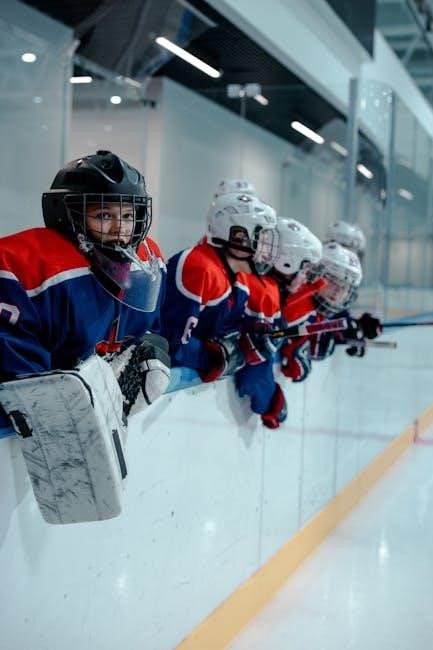
Age and Skill Level Considerations
Goalie pad sizing varies by age and skill level, with youth, junior, intermediate, and senior options. Brands tailor pads to balance protection, mobility, and growth for each group.
Youth Goalie Pads (Ages 4-6)
Youth goalie pads for ages 4-6 are designed for young players just starting out. These pads are smaller, lighter, and provide essential protection while allowing ease of movement. Sizes typically range from 22 to 24 inches, with narrower widths to fit smaller legs. The focus is on comfort and mobility, with soft padding and adjustable straps for a secure fit. Growth room is built in to accommodate developing players. Proper sizing ensures the pad doesn’t overwhelm the young goalie, fostering confidence and skill development. Brands often offer junior-specific designs tailored to meet the needs of this age group.
Junior Goalie Pads (Ages 6-10)
Junior goalie pads, designed for ages 6-10, offer a balance between protection and mobility as young goalies develop their skills. These pads typically range from 25 to 30 inches in length, with widths between 9 and 10 inches. They feature adjustable straps and flexible materials to accommodate growing bodies. The design emphasizes ease of movement, allowing junior goalies to maneuver effectively. Proper fitting ensures the pad stays secure while the goalie moves, with a focus on comfort and durability. Brands often include growth room in these pads to extend their use as the player grows. This age group sees significant skill progression, making the right pad choice essential for confidence and performance development.
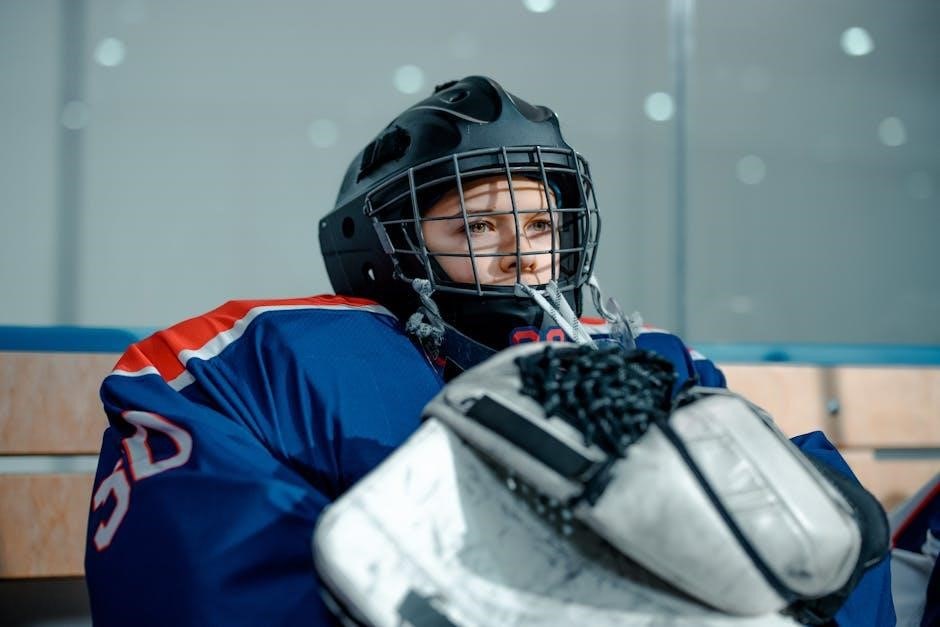
Intermediate and Senior Goalie Pads
Intermediate and senior goalie pads are designed for players aged 11 and above, offering advanced protection and mobility for serious play. These pads typically range from 29 to 34 inches in length, with widths between 10 and 11 inches. They feature higher-quality materials for durability and performance, often catering to specific playing styles, such as butterfly or hybrid goalies. The design emphasizes a balance between flexibility and rigidity, ensuring optimal movement while maintaining protection. Senior pads often include customizable options for a tailored fit, meeting the demands of higher-level competition. Proper sizing ensures the pad stays secure, maximizing both comfort and performance.
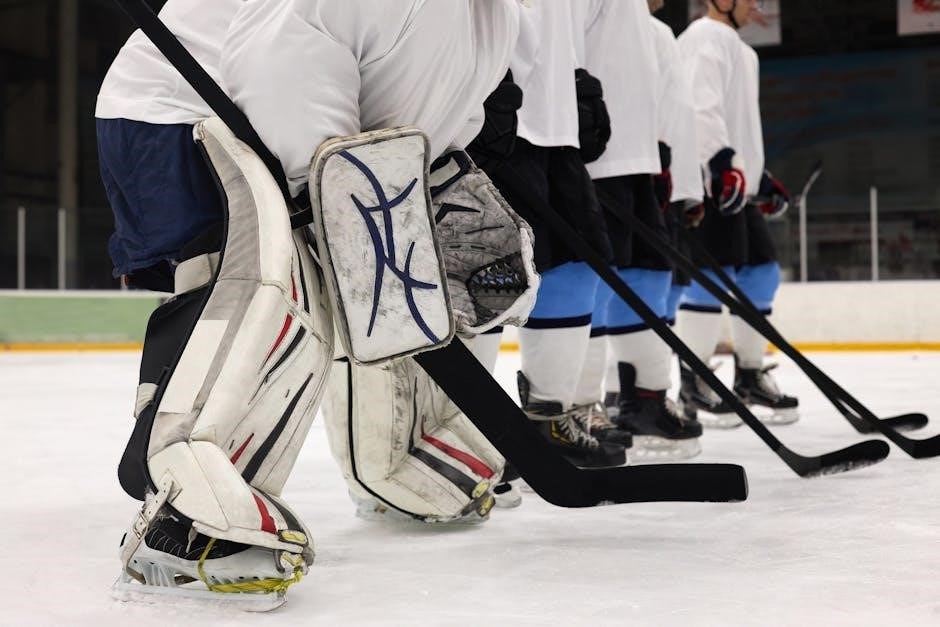
NHL Rule Changes and Pad Size Regulations
NHL rule changes have reduced goalie pad sizes to enhance skating mobility and performance, ensuring equipment fits proportionally to the goaltender’s body while maintaining protection standards.
Impact on Goalie Pad Sizing
The NHL’s rule changes have directly influenced goalie pad sizing by reducing overall bulk and emphasizing proportional fit to the goaltender’s body. These regulations aim to improve skating mobility and performance while maintaining protection. The changes include stricter limits on chest protectors and leg pad dimensions, ensuring pads do not exceed necessary size. This shift has prompted manufacturers to design pads with precise measurements, balancing protection and agility. Additionally, the rules encourage younger goalies to adopt properly fitted gear, promoting better technique and mobility from an early age. The adjustments have also led to a focus on customized sizing options to meet individual needs. Overall, the rule changes have enhanced the balance between protection and performance in modern goaltending.
Fit and Comfort: Beyond Measurements
Proper fit ensures optimal performance and comfort, balancing protection with mobility. Materials and flexibility play a key role in achieving a comfortable, responsive fit for goalies.
How to Ensure Optimal Fit
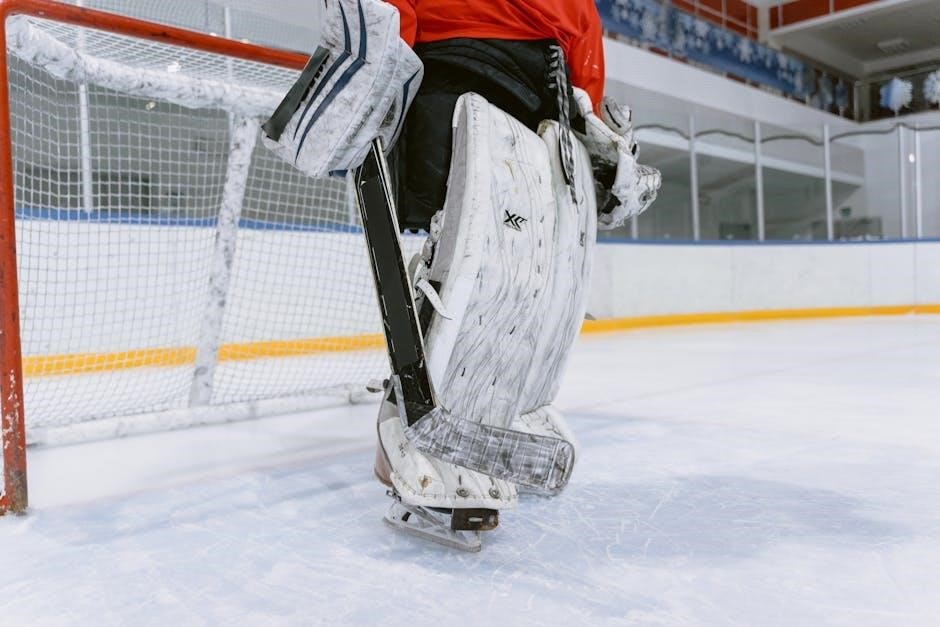
To ensure optimal fit, start with accurate measurements of skate size, instep to knee, and thigh rise. Try pads on if possible, as fit can vary by brand. Look for pads that allow freedom of movement while providing ample protection. The boot should align with the skate, and the shin guards should cover the instep to the knee. The thigh rise should sit comfortably, avoiding restrictive pressure. Mobility is key; goalies need to move freely while maintaining protection. Proper fit enhances performance, so prioritize comfort and flexibility when selecting pads.
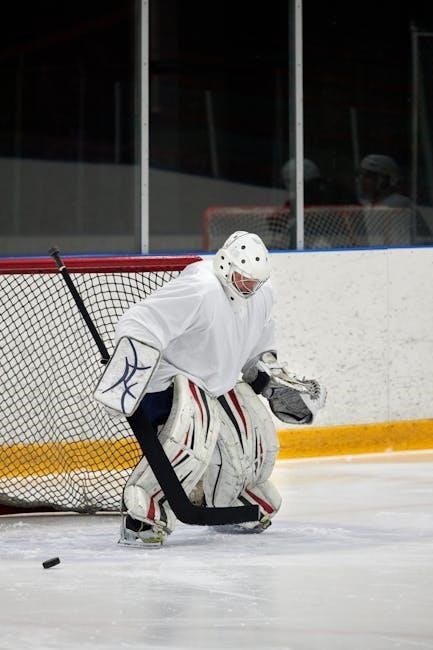
Protection vs. Mobility
Choosing between protection and mobility is a critical balance for goalies. Pads must protect against impacts while allowing quick movements. Thicker padding offers greater protection but may restrict flexibility. Slimmer designs enhance agility but may compromise on safety. Hybrid styles combine both, catering to dynamic goalies. Consider playing style and position demands when selecting. Proper fit ensures both protection and mobility, avoiding bulkiness or gaps. Modern designs often blend these aspects, offering tailored solutions for different preferences. Prioritize based on your game strategy and personal comfort to maintain peak performance and safety.
Properly fitted goalie pads enhance performance and safety. Consider your skating style, position, and personal comfort. Try pads on if possible, and consult sizing guides for accuracy.
Proper goalie pad sizing is essential for performance, comfort, and protection. Key measurements include skate size, instep to knee, and knee to thigh rise. The ATK system helps determine fit, while NHL rule changes regulate pad dimensions for fairness. Brands like Bauer and True Hockey offer specific sizing charts, catering to different styles. Youth, junior, and senior goalies require pads suited to their age and skill level. Ensure optimal fit by balancing protection and mobility, and consider personal preferences and playing style. Always consult brand guides and measure carefully for the best fit.
Final Recommendations for Choosing the Right Goalie Pads
When selecting goalie pads, prioritize proper fit and comfort while ensuring protection. Measure skate size, instep to knee, and thigh rise accurately. Use the ATK system for precise sizing, and consult brand-specific charts for Bauer, True Hockey, and others. Consider age and skill level, with youth pads focusing on growth and senior pads on performance. Adhere to NHL size regulations for fair play. Balance protection and mobility based on your style—Butterfly or Hybrid. Try pads on if possible and seek expert advice for optimal fit. Prioritize quality materials and features that align with your playing style and positional demands.
